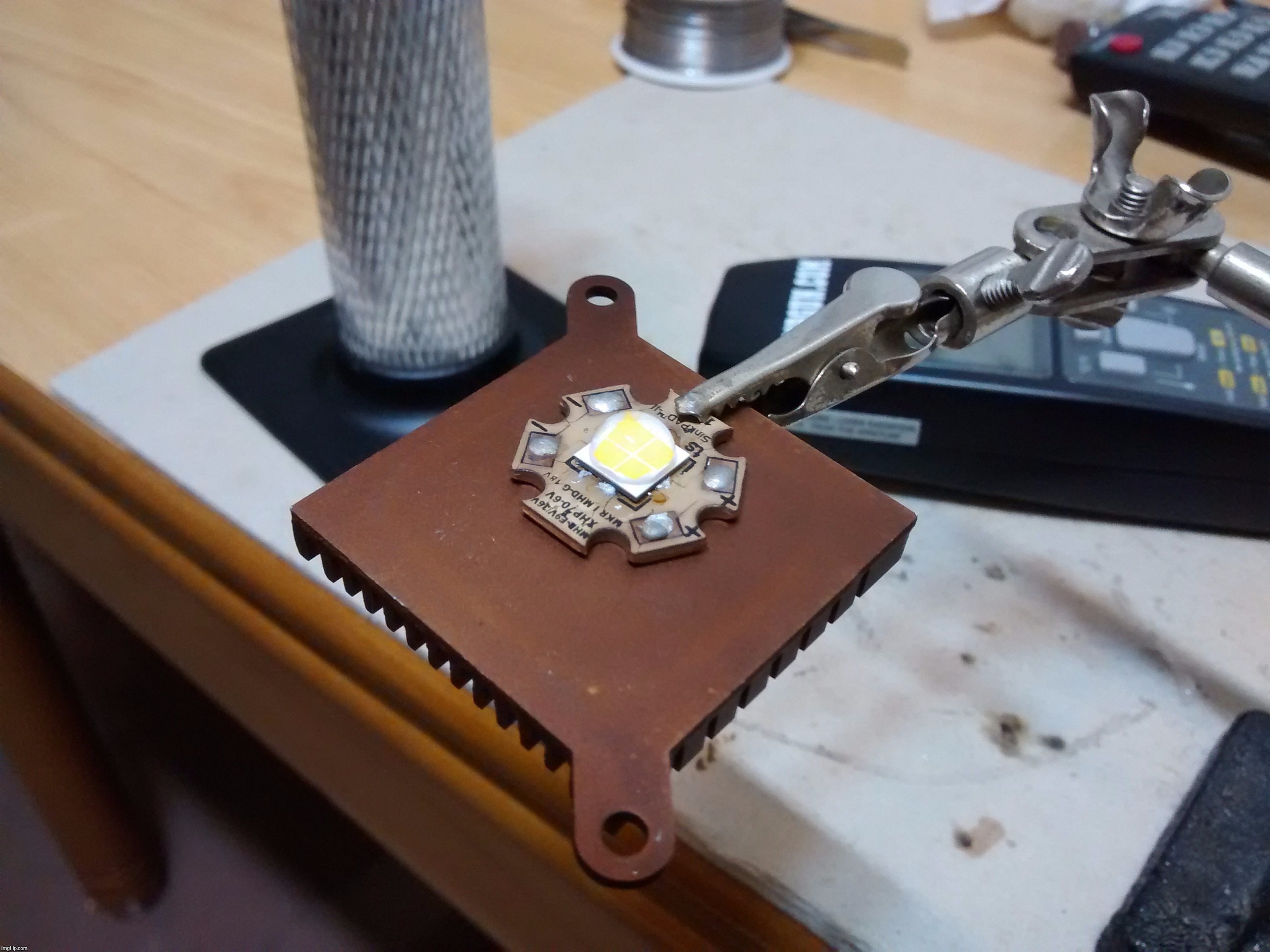I’m betting everything on that sinkpad that isn’t copper actually “repels” the solder. It has to, otherwise yes, it would short out.
Of course, whatever is in between the contact pads and the thermal one “repels” the solder.
When converting a non-DTP copper board to DTP via milling the thermal/central pad even to the very edge of the contact ones, the same behaviour can be observed: it's the dielectric layer, of course.
Take a look at these base plates:
- 20mm Copper Base Plate for CREE XHP70/MK-R LED Emitters
- 20mm Copper Base Plate for CREE XHP70 LED Emitters
These look like… unbranded Sinkpads!
I bet you my kingdom they come from the same OEM, but the Sinkpads undergo custom tailoring.
By the way, just had some more reflowing practice:

This time it went really shiny. That small heatsink (which once cooled the northbridge of an 8KHA+) is my new reflowing pan, thanks to it I've been able to carefully monitor the reflowing temp. ![]()
Cheers ^:)
Hi Kusie,
Yes, your correct. 3 pads one for + and - and one for heat. I do put extra solder in the center, and then move the LED from side to side to make sure all pads are covered. When you tap on the top of the dome fast like shown in the video the extra solder will eject from under the LED. Pushing down on the emitter like that to get rid of the extra will ensure there are no shorts. Its very very rare that you will ever get a short doing it this way.
You are correct about the cavity in the center of a sinkpad. The reason that cheap LED stars do not have that cavity is because they fill it with substrate material. This material is a very poor conductor of heat. In the sinkpad that little gap is filled with solder which is a much better conductor of heat.
The process for re flowing will be the same on either type of board.
Thank you very much for your detailed answer, much appreciated!
K.
Here is a related thread ![]()
bump…
Though one should be careful doing this and without shaky hand. When I reflowed Photo Red XP-Es to a 3XP board (and soldering it to the triple spacer and stock pill) over a hot plate while being ill, I ripped off the silicone dome when trying to adjust the LED. It did survive the experience though I harbour suspicions that its light output is worse than its brethren.
Hot de-dome is a method used by several around here. I don’t know about XP-E, but the XP-E2 R3 that I have are very easy to de-dome with heat. Any time you de-dome an LED, you will lose lumens, but I doubt there was any damage done. Maybe you should de-dome the brethren so that they are all the same. :smiling_imp:
Taught an old dog a new trick. Wonderfull video thanks for you time. :+1:
VoB
really excellent
needs to be a sticky
dittos.
Thank you everyone. Hearing that my work has helped someone makes this very worth while to me.
Very nice, thanks a lot! Sticky’d.
VoB
really excellent
needs to be a sticky
dittos.
Very nice, thanks a lot! Sticky’d.
WoooHoooo!
Thank you!
I’m planning to do my first emitter reflow in the next week or two, this video was incredibly useful. Thanks a ton.
Good luck on the reflow sac. Quality solder paste goes along way to a perfect job if your going that way and dont forget to get the + and - in the correct orientation. ![]()
I’m planning to do my first emitter reflow in the next week or two, this video was incredibly useful. Thanks a ton.
Thank you, and good lux!
If you have flux soldering tin you can do the same as with paste
Its best to add some mass so the temperature does not raise too quick, I used a 12mm iron plate and on top 6mm black anodisated aluminium plate on my induction stove
On the Aluminium I use a IR thermometer but it works great if I heat up till solder melts and then reduce the power of the stove
My very first reflow using a sinkpad an XHP70 with a skillet and hot plate. I will purchase a Infrared thermometer from Harbor Freight to do some testing and also see how hot the sinkpad gets as soon as the solder paste turns into liquid solder. ![]()
BTW, Harbor Freight is having a good sale right now in my area, so I can purchase an Infrared thermometer with a coupon for $17.99! I guess that’s a good deal…lol… :question:
